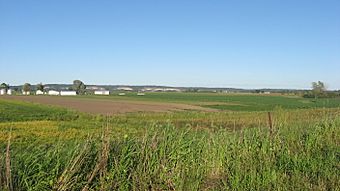Kolmer Site facts for kids
Quick facts for kids |
|
|
Kolmer Site
|
|
|
U.S. Historic district
Contributing property |
|

Overview of the site from the west
|
|
| Location | Levee Rd., west of Fort Chartres State Park |
|---|---|
| Nearest city | Prairie du Rocher, Illinois |
| Area | 89 acres (36 ha) |
| Built | 1720 |
| Part of | French Colonial Historic District (ID74000772) |
| NRHP reference No. | 74000773 |
| Added to NRHP | May 1, 1974 |
The Kolmer Site is an archaeological site in Illinois, a state in the United States. An archaeological site is a place where people lived long ago, and we can find clues about their lives. This site is found near the towns of Kaskaskia and Prairie du Rocher in western Randolph County.
The Kolmer Site was once an early Native American village during the time when the French were exploring and settling in this area. It is a very important place for understanding history. Because of its special place in time and culture, it has been recognized as a historic site at the national level.
Contents
A Look at Kolmer Site History
Long ago, explorers like René-Robert Cavelier, Sieur de La Salle traveled along the Mississippi and Ohio Rivers. They claimed these lands for New France. Soon after, Catholic missionaries arrived. They taught the Illini people about their faith. Some Illini who became Christians started villages along the river. These villages included Cahokia, Kaskaskia, and Peoria.
These villages were not very big compared to towns today. But they were similar in size to the French settlements nearby. For example, in 1750, three Illini villages had fewer than 800 people. At the same time, five French villages in the same area had about 1,100 French people and 300 Black people.
The Michigamea Village Story
The village at the Kolmer Site was started in 1720. It was home to a group of the Illini people called the Michigamea. This village thrived for a little over 30 years. But in 1752, something terrible happened. A group of tribes, including the Fox, Sioux, and Cherokees, attacked the village suddenly.
Even though the village had a strong wooden fence called a stockade for protection, the Michigamea could not stop the invaders. Many people were killed, and others were captured. The people who survived had to run away to Kaskaskia. The attackers then burned the empty village. Instead of rebuilding, the Michigamea started a new village nearby. Today, archaeologists call this new place the Waterman Site.
Changes in Control of the Land
The French lost control of the American Bottom area after the Treaty of Paris in 1763. This treaty gave all the land east of the Mississippi River to the British.
Later, the American Revolution changed things again. At first, the French settlers and local Native Americans liked the British. But a clever leader named George Rogers Clark convinced them to support the Americans. The Kolmer residents' church in Kaskaskia, called the Immaculate Conception, survived a big flood in the 1800s. Even though Kaskaskia became a small island, church services are still held there every week.
Why Kolmer Site is Important to Study
When the Michigamea lived at the Kolmer Site, it was right next to the Mississippi River. But the river has changed its path over time. Now, the site is about a mile (more than 1.5 kilometers) away from the river. It is also behind a levee system built to control the river.
Today, the land is used for farming. The soil is a mix of sand and clay. The area has stayed much like it was long ago because not many new buildings have been built there.
Clues from the Past
Because the attack in 1752 happened so fast, the Michigamea likely left many of their belongings behind. And since they built a new village instead of fixing the old one, many artifacts (objects made by people) probably stayed where they were. This makes the Kolmer Site very important for archaeologists. It can teach us a lot about the Illini people during this time.
The site is even more important because of the Michigamea's connection with the French. Any artifacts found here can be dated to a specific 30-year period. By comparing these artifacts to those from other sites influenced by the French, archaeologists can better understand places that are harder to date. Also, the artifacts might show how the Michigamea changed from a traveling lifestyle to one influenced by European ways.
The Kolmer Site was closely linked to the main French settlements in the upper Mississippi valley. This makes it a key part of a region that is special in the United States for showing what colonial France was like. This is especially true because the larger old Kaskaskia village is now under the Mississippi River.
Kolmer Site: A Protected Place
In the spring of 1974, the Kolmer Site was added to the National Register of Historic Places in two ways. It was listed on its own in early May because of its archaeological importance. A month before that, it was added as part of a larger historic district.
This district is called the French Colonial Historic District. It protects about 22 square miles of land connected to early French settlement in the area. The Kolmer Site was named one of its most important contributing properties. Other important places in this district include very old sites like the Modoc Rock Shelter. It also includes French buildings or sites influenced by the French, such as the Creole House, the Pierre Menard House, Fort de Chartres, and the site of Fort Kaskaskia. The Waterman Site, where the Michigamea lived after their first village was destroyed, is also part of this district.



